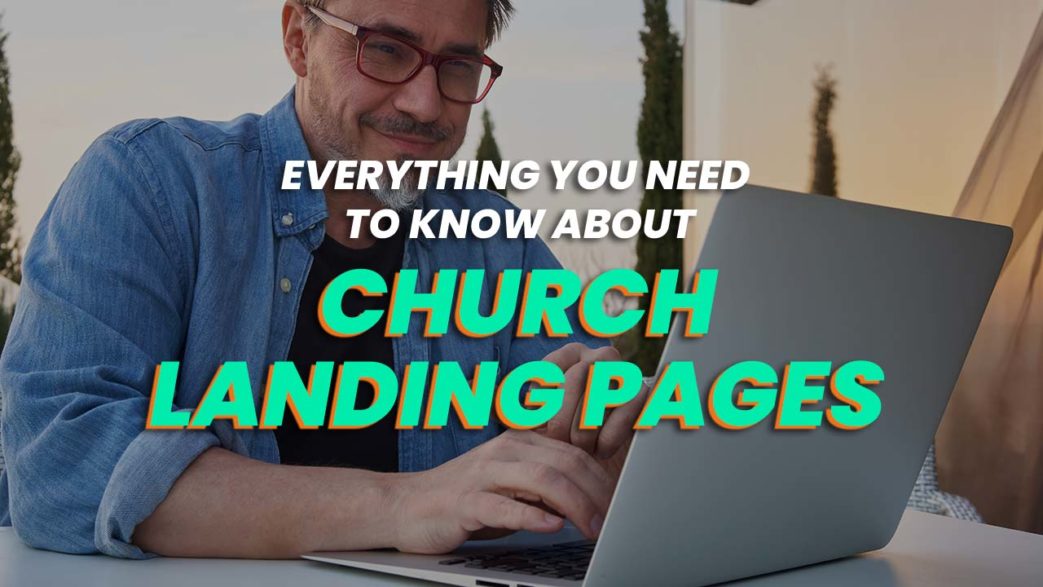You’ve seen them and interacted with them, but are church landing pages the right strategy for your church?
It’s incredibly common to see landing pages for almost any product or service, including events, fundraisers, and even ministry groups for churches. However, many churches still haven’t embraced this highly effective marketing technique.
When it comes to targeted marketing, it’s hard to beat a landing page. While they’re technically just another web page, they’ll help increase conversions, no matter what your church’s goal might be.
Table of contents
- Purpose Of Church Landing Pages
- Do You Need A Landing Page
- Types Of Landing Pages
- Focusing On A Single CTA
- What Makes Landing Pages Different
- Limit Links To Avoid Distractions
- Value Of Images And Videos
- Answer Every Question Possible
- Make Interacting Easy
- Setting Your Landing Page’s Goal
- Place Your Message Above The Fold
- Focus On Your Audience Vs. The Church
- Market Your Church Landing Page

Purpose Of Church Landing Pages
The purpose is to let people know more about a specific event, product, service or anything else related to your church. For instance, if you’re just trying to boost church newsletter signups, you might have a landing page that focuses specifically on your newsletter.
As the name implies, when people “land” on the page, they’re seeking information on a single topic. This isn’t the place for general content. You want to provide a wealth of information that encourages people to take action. Naturally, the action will vary based on what you want to achieve. This could be registering for an event, volunteering, joining a ministry group or donating for a specific cause your church is helping with.
Consider a landing page as the go-to source for your church’s goal. Visitors shouldn’t need to go to any other pages as this single page answers everything and gets them excited to take the intended action.
Do You Need A Landing Page
You have a blog and web pages, so do you really need a landing page? This is a tricky question to answer. Some brands just use a blog post as their landing page to keep things simple. It’s a good strategy, but it’s not a traditional landing page.
If you need to go more in-depth for an event or service for your church while increasing conversions (such as new visitors, online tithing, event signups, etc.), church landing pages are a good idea. You can create them just like a normal page in WordPress. However, they’ll usually be free of most of the navigational elements on the rest of your web pages.
It’s important to note that landing pages aren’t always a permanent fixture on your site. For instance, if you’re trying to increase new visitors during Christmas, you’d take down your landing page after Christmas. You can always revise it with new information and republish the next year.
Types Of Landing Pages
There are usually four main types of landing pages your church can use. Each has its benefits and choosing the right one affects how well it might perform.
The biggest debate comes down to whether you should create a short-form or long-form landing page. We recently talked about the SEO benefits of long-form content, which can also apply to longer landing pages. However, much like with any type of long-form content, there isn’t a single right answer as to what length is best.
CXL calls the debate between short and long landing pages a double-edged sword. This is because while some brands drastically increase conversions by increasing their landing page’s length, other brands see the exact opposite result.
Ideally, only use as much content as needed. For instance, if you have several videos on your landing page, you probably won’t need as much written content. If you find yourself simply repeating the same information over and over, it’s probably best to keep your landing page short. The last thing you want is for people to get bored and navigate away.
In addition to short and long-form landing pages, there are also video and static landing pages. Video pages, as you might guess, include at least one video, but usually more than one. Instead of written content, the focus is more on video. This allows you to answer questions in a more engaging, friendly way. Of course, people might not always be able to listen to your videos, so make sure you include captions and at least an text overview on your landing page.
Static pages usually focus on text and images instead of videos. No matter what type of landing page you use, visuals are vital. This can include images, videos, infographics, colorful buttons and so on. Visual engage the reader and lead the eye naturally from section to section.
Focusing On A Single CTA
It’s easy to get carried away with church landing pages. You want to accomplish a lot on a single page. However, one thing that makes landing pages so effective is they’re highly focused. There’s on a single call-to-action per page. If you have five ministry groups you want people to join, create five landing pages.
If you have more than one CTA, it gets confusing to the visitor. They’re not sure what information applies to which CTA. Plus, they might stop after the first CTA, completely missing your other objectives.
It’s okay to offer a few different options as your CTA. For instance, if you’re hosting a local community event to help a family in need, your overall call-to-action would be to help the family. However, you can offer multiple ways to do so, such as donating online, volunteering during the event, donating physical items before or during the event or just sharing the information with others.
Set a single target goal and focus the entire page on just that. It’s fine to have more than one landing page.
What Makes Landing Pages Different
So what actually makes church landing pages different than other web pages or blog posts? In our post Top 6 Pages Every Church Website Should Have, we list the types of content each page needs. As you might notice, there’s a variety of information on each page. For example, the home page itself serves as an overview of your entire site.
Blog posts might focus on a single topic, but they’re still not quite as focused as a landing page. Plus, most blog posts aren’t quite as marketing-centric. They’re designed to offer more information about various subjects, such as explaining confusing scripture or issues Christians face.
Landing pages are designed specifically for marketing. They’re not just information about your church or great content to increase engagement between services. You are marketing something important going on in your church. As such, you need to focus on the benefits, answer questions and fully explain why visitors should act right now.
Limit Links To Avoid Distractions
Another way church landing pages differ from other parts of your website is they usually only contain a few links. The links are for converting, such as leading to an online tithing platform, or just to lead back to your church’s home page. In many cases, there aren’t any links at all. There is only a form to fill out along with a button to submit it.
This is why landing pages often don’t have the same types of menus and navigational features the rest of your site includes. Instead of tempting them away from the rest of the landing page, their only option is to scroll and check out the rest of the content. This increases the chance of conversions. While you might want them to eventually come back to your church’s main website, you might want to wait to give them the link until they’ve interacted with your CTA. You can also place a link to your church home page below the CTA.
Value Of Images And Videos
It’s a well known fact that a high-quality video helps boosts conversions. For instance, StacksandStacks.com increased conversions by 144% by adding product videos. Plus, visitors usually stay on your site twice as long. While these were product videos, the same benefits apply to landing pages.
Yes, you could have thousands and thousands of words of text to describe every reason someone should donate or participate in an upcoming event, a video says it quicker and easier. Plus, it seems more personal and friendly, which is how you want people to see your church.
With church landing pages, you do need more than just a video or two. A landing page, no matter how many videos you might have, still needs text. Images and videos help break up the text and leave people with a visual representation of the text. As a result, they’ll relate to it more and remember the details better. Ideally, have at least one video on your landing page along with a handful of relevant images to break up text.

Answer Every Question Possible
Since you’re focused on a single topic, your landing page needs to cover everything about it. For instance, if the page is about getting tickets for a church event, you’d want to include the following:
- Date/time
- Price
- Talent or entertainment
- Example(s) of a similar past event
- What the proceeds are for
- Benefits of attending
- Any special considerations (such as needing to bring a chair to an outdoor event)
- Why your church is the perfect venue
- How to get there and where to park
- How to buy tickets
The more details you provide, the more likely visitors are to convert. If you leave them with questions, they’re more likely to leave the page. However, it’s a good idea to provide a contact option just in case there’s a question you may have missed.
Make Interacting Easy
So far, we covered the importance of skipping links and your typical menu. To make interacting with your landing page even easier, use a natural flow as visitors proceed down the page. Whether you just have a video, a few short paragraphs and a form to fill out or multiple videos/images with hundreds of words of text, keep visitors engaged from start to finish.
For instance, if you’re talking about how useful your church newsletter is, include images or excerpts of your latest newsletter directly below that. You could then talk about your process of creating a useful newsletter and add a video showing snippets of the process.
Think about the questions someone might ask before interacting with your CTA. Answer each of them, building to the final CTA, which is signing up for whatever your CTA might be.
Check out some example landing pages from popular brands to see how things work. As you’ll notice, many of them keep things short and sweet, which shows visitors the brand values their time too. If you need some more examples, try these 19 pages.
Setting Your Landing Page’s Goal
The hardest part of creating church landing pages is having a set goal. Before you write any text or film any videos, set the goal. Are you trying to just reach more people? Do you want to build your online audience? Is the goal to increase new visitors?
Whatever the goal, this sets the tone for the entire page. For instance, if you’re trying to increase new visitors, your landing page would focus on the benefits your church offers new visitors. The CTA might be a download of free resources and a subscription to your church newsletter to let them learn more before visiting in person.
Place Your Message Above The Fold
Since people make a judgement about whether they want to scroll further in just a few seconds, you need to make your point above the fold. This is the area of your site that displays before someone needs to scroll. A powerful question, a major benefit or even just the purpose of your landing page works well for this purpose. A great image to go with it helps too. Remember, keep it short since many visitors may be coming from mobile devices.
Focus On Your Audience Vs. The Church
Yes, church landing pages help your church meet specific goals. However, the focus should always be on your audience. How does what your church is offering or asking for help the visitor? If they donate to aid a specific part of your church, why would that make them feel good? If you focus on the benefits to the visitor, they’re more likely to take the action you want.
Market Your Church Landing Page
Finally, market your church landing pages. Consider using ads, such as Google ads or Facebook ads, to drive traffic to the page. Write a blog post about it and link to the page. Of course, optimizing the landing page with the right keywords also helps more people find your page organically.
Landing pages are ideal to target specific goals, but your church still needs an active website for growth and online engagement. Contact us today to learn how we can help your church.




